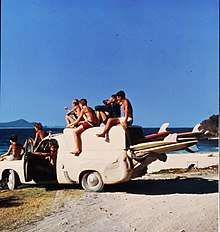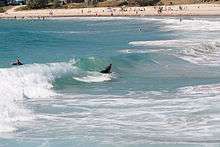Surfing in Australia
| Country | Australia |
|---|---|
| Governing body | Surfing Australia |
| National team | Australia |
National competitions | |
Club competitions | |
International competitions | |

Surfing in Australia refers to surfing in Australia. Australia is renowned as one of the worlds premier surfing destinations.[1] Surfing underpins an important part of the Australian coastal fabric. It forms part of a lifestyle in which millions participate with a mystique in which millions more have a documented interest.[2] Australian surfboard-makers have driven innovation in surfboard-design and production since the mid-1960s. Australia has launched corporate giants such as Billabong and Quiksilver.[3]
No surfing is possible in many part of northern Australia due to coral reefs subduing waves. Modern surfboard design has been shaped by both Australian and Californian developments.[4] For many years the sport was closely associated with the surf life saving movement in Australia.
Governing body
Surfing Australia is the national sporting body which guides and promotes the development of surfing.
Tournaments
Major Australian tournaments includes the Men's Samsung Galaxy Championship Tour,[5] Quiksilver Pro Gold Coast(Gold coast, Queensland), Rip Curl Pro Bells Beach (Bells Beach, Victoria) and the Drug AwareDrug Aware Margaret River Pro (Margaret river, Western Australia). Other tournaments include the Australian Boardriders Battle, Australian Open of Surfing, Beachley Classic, Breaka Burleigh Pro and the Noosa Festival of Surfing.

History

Surfing was brought to Australia in 1915 by Hawaiian Duke Kahanamoku.[6] He demonstrated this ancient Hawaiian board riding technique at Freshwater (or Harbord) in Sydney, New South Wales. Duke Kahanamoku's board is now on display in the northeast end of the Freshwater Surf lifesaving club, Sydney, Australia. In 1956, a team of lifeguards from the USA introduced malibu boards to Australia.[7]
In the 1960s, Australian surfboard designer Bob McTavish invented the V-bottom surfboard, which is considered instrumental to the development of shortboard surfing.[8]
Australia has produced multiple ASP world champions.[9] Such as: Wayne Bartholomew, Tom Carroll, Barton Lynch, Damien Hardman, Mark Occhilupo, Mick Fanning, Stephanie Gilmore, Layne Beachley, Wendy Botha, Pauline Menzcer, Chelsea Georgeson and Mark Richards.[10]
The World Surf League incorporates three major championship titles held in Australia. These include the Quiksilver Pro Gold Coast, Rip Curl Pro Bells Beach, and the Drug Aware Margaret River Pro. One of the most successful Australian surfers, Mick Fanning, has managed to win four titles at Bells Beach, earning him the current number one spot in the surfing ranks.[11]
Culture

The culture of surfing has grown dramatically from just being a relaxed way of living to what has now become a mainstream sport. These progressions of the sport have led to research on the health benefits of surfing. Surfing promotes cardiovascular fitness, muscular strength increases and balance. The strength and cardiovascular and strength benefits of surfing come from the constant paddling through the water, increasing arm and back strength whilst also getting the heart rate up. Surfing also gives one a chance to think and relax in an environment that decreases stress and relaxes the muscles.[12]
Demographics
There are approximately 2.5 million recreational surfers in Australia, 420,000 annual surf participants,107 surf schools and 2,292 accredited surfing coaches. Over 1 in 10 Australians surf as a recreational activity.
Australian World Title holders
Men
|
|
Women
|
|
Australian Surfboard Shapers
Australia is a leading country in surfing and surf board design. shaping is an important part of the innovation and progressinon of surfing. Australian shapers include Darren Handley who is shaper to world champions Mick Fanning and Stephanie Gilmore.[13] Mark Richards (4 times World Champion) is also an Australian Surfing and Surfboard shaping legend who shaped his own boards during his time on the world tour.[14]
See also
References
- ↑ "Australian Geographic". Australian Geographic. 2014.
- ↑ "About Surfing Australia". Surfing Australia. 2015.
- ↑ Warren, Andrew (2013). "MAKING THINGS IN A HIGH-DOLLAR AUSTRALIA: THE CASE OF THE SURFBOARD INDUSTRY". JOURNAL OF AUSTRALIAN POLITICAL ECONOMY No 71.
- ↑ Ford, Nick; David Brown (2006). Surfing and Social Theory: Experience, Embodiment and Narrative of the Dream Glide. Taylor & Francis. p. 52. ISBN 0415334330. Retrieved 16 January 2016.
- ↑ World Surf League, World Surf League (2015-04-15). "Men's Samsung Galaxy Championship Tour". World Surf League. World Surf League. Retrieved 2015-04-15.
- ↑ Wendy Lewis, Simon Balderstone and John Bowan (2006). Events That Shaped Australia. New Holland. p. 115. ISBN 978-1-74110-492-9.
- ↑ Vertinsky, Patricia Anne; John Bale (2004). Sites of Sport: Space, Place, Experience. Psychology Press. p. 117. ISBN 0714682810. Retrieved 16 January 2016.
- ↑ "History Of Surfing Innovation Part 5 - Disrupt Surfing". Disrupt Surfing. Retrieved 2015-12-22.
- ↑ DiMartino, Jay (2015). "Australia's surfing history". about sport.
- ↑ "Australia's Surfing History". about sport.
- ↑ "Mick Fanning wins men's title at Bells Beach". ABC News. Retrieved 2015-04-15.
- ↑ "Surfing - health benefits - Better Health Channel". Retrieved 2015-04-15.
- ↑ Handley, Darren (2015). "Blog". Darren Handley Designs. © 2015 DHD Surf - Performance Surfboards. All Rights Reserved.
- ↑ Baker, Tim (2013). Australia's Century of Surf. North Sydney NSW: Random House Australia Pty Ltd. pp. 184–185. ISBN 978 1 74275 828 2.
External links
 Media related to Surfing in Australia at Wikimedia Commons
Media related to Surfing in Australia at Wikimedia Commons
